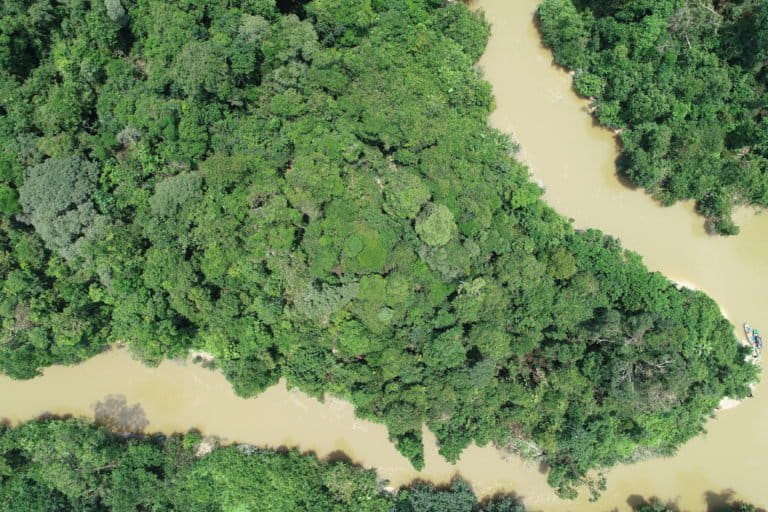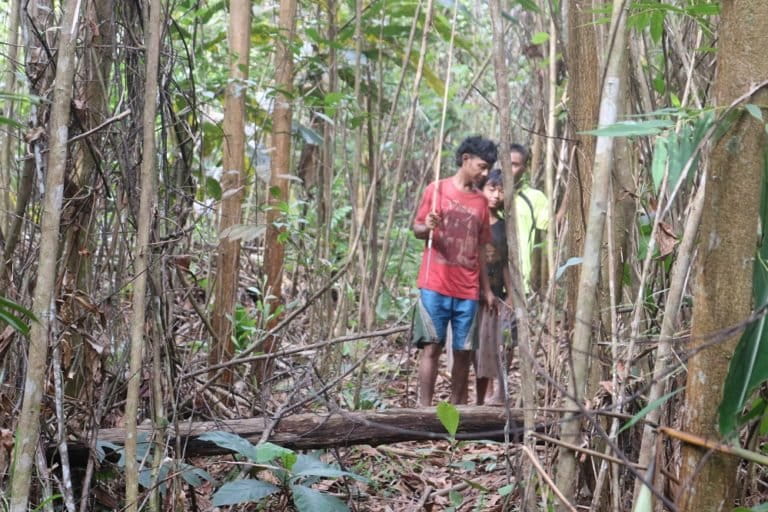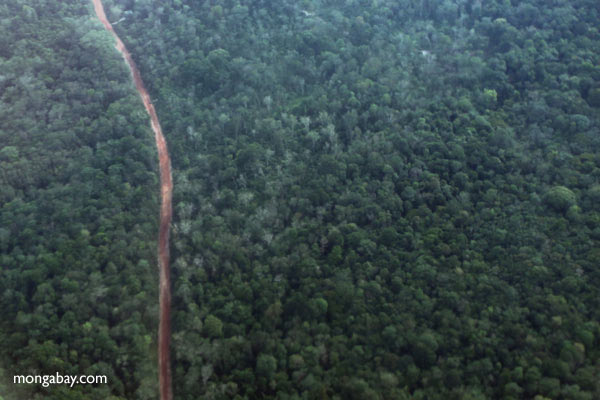- The Harapan forest in southern Sumatra, Indonesia, faces threats from illegal logging, encroachment by oil palm growers, poaching of its wildlife, and the loss of funding for conservation initiatives.
- An indigenous community, conservation managers and activists have highlighted another danger that risks fragmenting the biodiverse lowland rainforest: a coal-trucking road that would slice through the area.
- Local authorities reviewing the project proposal have called on the company behind it to consider a road that skirts the forest instead, but the company has not yet published a revised plan.
- The forest’s Batin Sembilan indigenous group says the creation of a road will increase access into the forest, exacerbating long-simmering tensions with migrant communities they accuse of trying to grab the land.
JAMBI, Indonesia — A biodiverse patch of forest in Sumatra threatened by encroaching oil palm plantations and illegal logging could soon be carved up by a road for coal trucks.
The Harapan forest spans 769 square kilometers (300 square miles) in the provinces of Jambi and South Sumatra, and represents 20 percent of the remaining Sumatran lowland tropical rainforest. The forest is home to some 1,350 species including 133 globally threatened species like the Sumatran tiger and elephant.
But that may not be the case for much longer, as activists warn that plans to build a coal transport road through the forest could devastate the ecosystem, create more habitat fragmentation and facilitate further encroachment for logging, hunting and agriculture.
In September 2017, a mining company called PT Marga Bara Jaya (MBJ) submitted a proposal to the provincial governments to build an 88-kilometer (55-mile) road to transport coal from its mine in South Sumatra’s Musi Ruwas district to power plants in Musi Banyuasin district. A third of the road would slice through the forest.

Locally, the project has faced strong opposition.
“There’s a lot of resistance against the current plan,” said Yulqori, a coordinator for village forestry at the environmental NGO Indonesian Conservation Community Warsi.
Adam Aziz is director of operations at PT Restorasi Ekosistem Indonesia (REKI), the company set up by the local affiliate of BirdLife International to manage the conservation of the Harapan forest. He says the road project would undermine a decade of progress in restoring the forest and staving off the threats from fragmentation, deforestation, habitat degradation and biodiversity loss.
If the road is completed, the southern part of Harapan forest would be a gateway for encroachment and illegal logging, said REKI’s deputy manager for forest protection, Sarmita. “[This forest zone] is very close to the road that’s going to be built,” she said.
REKI works closely with the Batin Sembilan indigenous group to patrol the forest for illegal logging, farming and poaching activity. Their work has put them in frequent conflict, often violent, with migrant communities on the fringes of the forest.
Mat Tanding, an indigenous elder who heads the joint patrol team, said building a road through the forest to transport coal would only further stoke those tensions.
“[More] outsiders will definitely come into the area,” he said. “We will have more conflicts with the encroachers.”
The Batin Sembilan and REKI are not alone in their objection to the project. A coalition of 36 local and international civil-society groups has lambasted MBJ’s environmental impact assessment for the coal road development through the Harapan forest.
The coalition includes the Indigenous Peoples Alliance of the Archipelago (AMAN), the Our Forest Institute, the Zoological Society of London, the Our Tiger Forum, and the Indonesian Forum for Elephant Conservation.

In March, the coalition opposing the road project submitted a letter to South Sumatra commission that was reviewing MBJ’s environmental impact assessment. It said that while the road was intended for transporting coal, it would also encourage the transportation of forest and plantation produce, thereby encouraging illegal logging and farming within the forest. It also noted that the Musi Banyuasin district government had rejected MBJ’s environmental impact assessment.
The South Sumatra assessment commission subsequently ordered the company to revise its plan by having the road skirt the forest, using an existing road network, instead of cutting through it.
MBJ has agreed to revise its road plan, but has not yet published a new proposed route or indicated whether it will indeed consider upgrading existing roads around the forest. The company did not respond to requests for comment for this article.
MBJ wasn’t the first company to try develop a road here. In 2013, PT Musi Mitra Jaya, an obscure Indonesian company that government data only describes as “non-mining,” proposed a similar project, but was turned down by the forestry ministry.
MBJ, however, is better connected. It’s a subsidiary of PT Triaryani, which mines coal on three concessions spanning more than 2,100 hectares (5,200 acres) in Musi Rawas district. Triaryani was acquired in 2012 by PT Golden Eagle Energy, a subsidiary of Rajawali Corpora, a major Indonesian conglomerate.
MBJ’s road-building proposal received official support from the governors of both South Sumatra and Jambi. These recommendations bolstered the chances the project would be approved by the environment and forestry ministry. The ministry reportedly discussed the project’s environmental impact assessment in November 2018 and this past February.

The Harapan forest was previously a logging concession, before being designated in 2008 as Indonesia’s first ecosystem restoration concession (ERC). These are former concessions that private companies can license for restoration, the idea being to prevent these degraded logging sites from being permanently converted to oil palm plantations or smallholder farmland, by restoring them to their previous forested state.
It was put under the management of REKI, which since 2011 was funded by Danish government development aid. In that time, project has made great strides in restoration, but has been unable to completely stamp out encroachment into the area for hunting, logging and oil palm cultivation. At the end of 2018, the Danish funding ended, raising concerns about how much longer Harapan forest can hold out against the onslaught of illegal logging and farming.
Last year, 120 hectares (300 acres) of land within Harapan forest was cleared for oil palm farms, amid a reported plan by plantation company PT Perkebunan Sriwijaya of razing a total of 12,360 hectares for oil palms.

Land conflicts also plague the area. In 2015 REKI signed an agreement to manage the forest with the Batin Sembilan, a semi-nomadic people indigenous to the area who have historically relied on the forest. Other groups, however, say that REKI’s work to reforest areas that were cleared for farming after the land was logged has deprived them of their land, crops and livelihoods.
Tanding, the head of the forest patrol, said that in February this year, clashes between members of his tribe and outsiders turned violent. He said 60 people arrived by motorbike from the Sungai Bahar and Sungai Bungku migrant villages, wielding bladed weapons.
The crowd was looking for him, Tanding said, but after failing to find him, they attacked another member of the forest patrol, beating him badly enough that he had to be hospitalized.
“They wanted to evict us, but we refused,” Tanding said. “This is our home and the land belongs to our ancestors. We will protect this until we die.”
Munce, a fellow member of the Batin Sembilan, said the community’s survival hinges on the protecting the forest. “The forest is the source of happiness for the Batin Sembilan tribe,” he said. “If the road development is completed, we will lose our source of life.”

Clarification: A reference to the Harapan forest covering 40 percent of the remanining lowland tropical rainforest left on Earth was corrected on May 29.
This story was first reported by Mongabay’s Indonesia team and published here and here on our Indonesian site on March 25 and April 2, 2019.
FEEDBACK: Use this form to send a message to the author of this post. If you want to post a public comment, you can do that at the bottom of the page.